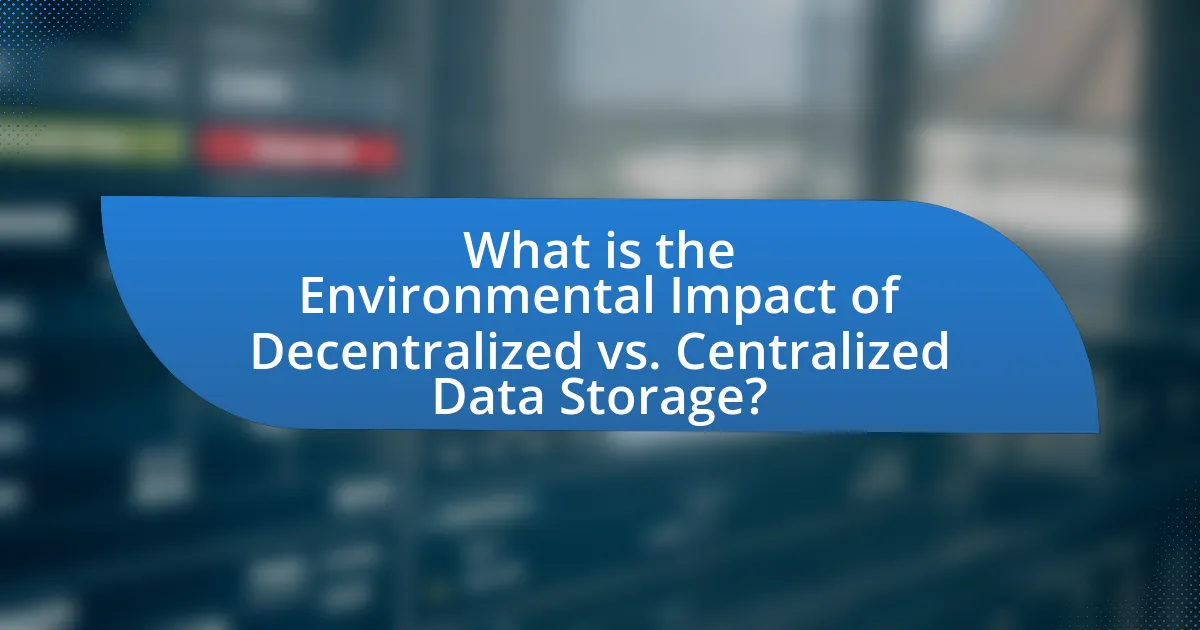The article examines the environmental impact of decentralized versus centralized data storage systems. It highlights that decentralized storage generally has a lower environmental footprint due to its ability to distribute data across multiple nodes, leading to more efficient resource utilization and reduced energy consumption. In contrast, centralized data storage relies on large data centers that consume significant energy and contribute to higher carbon emissions. The article discusses energy consumption patterns, the role of renewable energy, and the implications of data storage choices on climate change initiatives, emphasizing the importance of understanding these factors for sustainability efforts in technology.

What is the Environmental Impact of Decentralized vs. Centralized Data Storage?
Decentralized data storage generally has a lower environmental impact compared to centralized data storage. Centralized data centers consume significant amounts of energy, with estimates indicating that data centers account for about 1-2% of global electricity use, primarily due to cooling and operational demands. In contrast, decentralized storage systems can distribute data across multiple nodes, often utilizing underused resources and reducing the need for large, energy-intensive facilities. Additionally, decentralized systems can leverage renewable energy sources more effectively, as they can be located in areas with abundant clean energy. This distribution can lead to a more efficient overall energy consumption profile, thereby minimizing carbon emissions associated with data storage.
How do decentralized and centralized data storage systems differ in their environmental footprints?
Decentralized data storage systems generally have a lower environmental footprint compared to centralized systems. This is primarily because decentralized systems distribute data across multiple nodes, which can lead to more efficient resource utilization and reduced energy consumption per unit of data stored. In contrast, centralized data storage often relies on large data centers that consume significant amounts of energy for both operation and cooling, contributing to higher carbon emissions. For instance, a study by the International Energy Agency indicated that data centers accounted for about 1% of global electricity demand in 2020, with centralized systems being the major contributors to this figure.
What are the energy consumption patterns of decentralized data storage?
Decentralized data storage typically exhibits lower energy consumption patterns compared to centralized systems due to its distributed architecture. In decentralized storage, data is spread across multiple nodes, which can lead to more efficient resource utilization and reduced energy expenditure per unit of data stored. For instance, a study by the International Energy Agency indicates that decentralized systems can reduce energy consumption by up to 30% when compared to traditional centralized data centers, primarily because they leverage local resources and minimize the need for extensive cooling and infrastructure. Additionally, decentralized networks often utilize renewable energy sources, further decreasing their overall carbon footprint and energy demands.
How does centralized data storage contribute to carbon emissions?
Centralized data storage contributes to carbon emissions primarily through the energy consumption of large data centers. These facilities require significant electricity to power servers and cooling systems, leading to increased greenhouse gas emissions, especially when the energy source is fossil fuels. For instance, a report by the International Energy Agency indicates that data centers accounted for about 1% of global electricity demand in 2020, with projections suggesting this could rise as digital services expand. Consequently, the reliance on centralized data storage systems amplifies carbon footprints due to their high energy requirements and the associated emissions from energy production.
Why is understanding the environmental impact of data storage important?
Understanding the environmental impact of data storage is important because it directly influences sustainability efforts and resource management in technology. Data centers consume approximately 1-2% of global electricity, contributing significantly to carbon emissions. By recognizing the environmental footprint of data storage solutions, organizations can make informed decisions to optimize energy efficiency, reduce waste, and implement greener technologies, ultimately leading to a decrease in their overall ecological impact.
What role does data storage play in global energy consumption?
Data storage significantly contributes to global energy consumption, accounting for approximately 2-3% of total energy use worldwide. The energy demand arises from data centers, which require substantial electricity for both operation and cooling systems. For instance, a report by the International Energy Agency (IEA) indicates that data centers consumed about 200 terawatt-hours (TWh) of electricity in 2018, a figure projected to rise as digital data generation increases. This energy consumption impacts carbon emissions, particularly when sourced from fossil fuels, highlighting the environmental implications of data storage practices.
How can data storage choices influence climate change initiatives?
Data storage choices significantly influence climate change initiatives by determining energy consumption and carbon emissions associated with data centers. Centralized data storage typically requires large, energy-intensive facilities that contribute to higher greenhouse gas emissions, as evidenced by a 2020 study from the International Energy Agency, which reported that data centers accounted for about 1% of global electricity demand. In contrast, decentralized data storage solutions, such as edge computing, can reduce energy consumption by processing data closer to the source, thereby minimizing the need for extensive data transmission and reducing overall carbon footprints. This shift towards decentralized systems aligns with climate change initiatives aimed at reducing energy use and promoting sustainability.
What are the key factors influencing the environmental impact of data storage?
The key factors influencing the environmental impact of data storage include energy consumption, data center efficiency, and the source of energy used. Energy consumption is significant, as data centers account for approximately 1-2% of global electricity use, with projections indicating this could rise due to increasing data demands. Data center efficiency, measured by Power Usage Effectiveness (PUE), determines how much energy is used for computing versus cooling and other overhead, with lower PUE values indicating better efficiency. Additionally, the source of energy is crucial; renewable energy sources, such as wind and solar, have a lower environmental impact compared to fossil fuels, which contribute to greenhouse gas emissions. These factors collectively shape the overall carbon footprint and sustainability of data storage solutions.
How does the location of data centers affect their environmental impact?
The location of data centers significantly affects their environmental impact by influencing energy consumption, cooling requirements, and carbon emissions. Data centers situated in regions with access to renewable energy sources, such as hydroelectric power, can operate with a lower carbon footprint compared to those relying on fossil fuels. For instance, a study by the International Energy Agency indicates that data centers in areas with abundant renewable energy can reduce greenhouse gas emissions by up to 80%. Additionally, locations with cooler climates can minimize cooling energy needs, further decreasing overall energy consumption. Therefore, the geographical placement of data centers plays a crucial role in determining their sustainability and environmental effects.
What technologies are being developed to reduce the environmental impact of data storage?
Technologies being developed to reduce the environmental impact of data storage include energy-efficient data centers, advanced cooling systems, and data deduplication techniques. Energy-efficient data centers utilize renewable energy sources and optimize power usage effectiveness (PUE), significantly lowering carbon footprints. Advanced cooling systems, such as liquid cooling and free-air cooling, reduce energy consumption by maintaining optimal temperatures with less energy than traditional air conditioning. Data deduplication techniques minimize storage needs by eliminating redundant data, which in turn reduces the energy required for data storage and management. These innovations collectively contribute to a more sustainable approach to data storage, addressing the growing environmental concerns associated with digital data proliferation.
How do decentralized and centralized systems compare in terms of sustainability?
Decentralized systems generally offer greater sustainability compared to centralized systems. This is primarily due to their ability to distribute energy consumption and reduce single points of failure, which can lead to more efficient resource use. For instance, decentralized networks can utilize renewable energy sources more effectively, as they can be located closer to energy generation sites, minimizing transmission losses. In contrast, centralized systems often rely on large data centers that consume significant amounts of energy and contribute to higher carbon footprints. According to a study by the International Energy Agency, data centers accounted for about 1% of global electricity demand in 2020, highlighting the environmental impact of centralized infrastructures. Thus, decentralized systems tend to promote sustainability through improved energy efficiency and reduced environmental impact.
What are the implications of choosing one data storage method over the other?
Choosing between decentralized and centralized data storage significantly impacts energy consumption and carbon footprint. Centralized data storage typically requires large data centers that consume substantial energy, contributing to higher greenhouse gas emissions. For instance, a study by the International Energy Agency reported that data centers accounted for about 1% of global electricity demand in 2020. In contrast, decentralized storage can reduce energy usage by distributing data across multiple nodes, often utilizing underused resources and promoting energy efficiency. This method can lead to lower overall emissions, as it can leverage renewable energy sources more effectively. Therefore, the choice of data storage method directly influences environmental sustainability and energy efficiency.
What specific environmental benefits can decentralized data storage provide?
Decentralized data storage offers specific environmental benefits, primarily through reduced energy consumption and lower carbon emissions. By distributing data across multiple nodes, decentralized systems can optimize resource usage, leading to significant energy savings compared to centralized data centers, which often require substantial power for cooling and operation. For instance, a study by the International Energy Agency indicates that decentralized storage can reduce energy consumption by up to 30% due to more efficient load balancing and resource allocation. Additionally, decentralized systems can utilize renewable energy sources more effectively, further decreasing their carbon footprint. This shift not only mitigates the environmental impact of data storage but also promotes sustainability in technology infrastructure.
How does decentralized data storage promote renewable energy use?
Decentralized data storage promotes renewable energy use by enabling localized energy consumption and reducing reliance on centralized power grids. This system allows data centers to be situated near renewable energy sources, such as solar or wind farms, which can directly supply the energy needed for operations. For instance, a study by the International Renewable Energy Agency (IRENA) highlights that decentralized systems can utilize excess energy generated during peak production times, thus optimizing energy use and minimizing waste. Additionally, decentralized storage reduces transmission losses associated with long-distance energy transport, further enhancing the efficiency of renewable energy utilization.
What are the waste management implications of decentralized data storage?
Decentralized data storage has significant waste management implications, primarily due to the distributed nature of data centers and devices. This model can lead to increased electronic waste (e-waste) as numerous individual nodes, such as personal devices and smaller servers, are utilized instead of centralized, larger facilities. According to the Global E-Waste Monitor 2020 report by the United Nations, e-waste is the fastest-growing waste stream globally, with an estimated 53.6 million metric tons generated in 2019, highlighting the environmental challenges associated with increased electronic devices. Furthermore, decentralized systems may complicate recycling efforts, as diverse hardware components from various manufacturers can hinder efficient waste processing. Thus, while decentralized data storage offers benefits like enhanced security and resilience, it also raises critical concerns regarding e-waste management and environmental sustainability.
What challenges do centralized data storage systems face regarding environmental sustainability?
Centralized data storage systems face significant challenges regarding environmental sustainability, primarily due to their high energy consumption and carbon footprint. These systems typically require large data centers that consume vast amounts of electricity for both operation and cooling, contributing to greenhouse gas emissions. For instance, a report from the International Energy Agency (IEA) indicated that data centers accounted for about 1% of global electricity demand in 2020, a figure expected to rise as data usage increases. Additionally, centralized systems often rely on non-renewable energy sources, further exacerbating their environmental impact. The concentration of data storage in specific locations also leads to resource depletion and increased waste generation, as outdated hardware is frequently discarded rather than recycled.
How can centralized systems improve their energy efficiency?
Centralized systems can improve their energy efficiency by optimizing resource allocation and implementing advanced cooling technologies. By consolidating data processing and storage, centralized systems reduce redundancy and lower the overall energy consumption associated with maintaining multiple servers. For instance, data centers can utilize energy-efficient hardware and software solutions, such as virtualization, which allows multiple applications to run on a single server, thus minimizing energy use. Additionally, the use of hot aisle/cold aisle containment strategies can enhance cooling efficiency, leading to significant reductions in energy costs. According to the U.S. Department of Energy, optimizing data center operations can lead to energy savings of up to 30%.
What are the potential risks of centralized data storage on the environment?
Centralized data storage poses several potential risks to the environment, primarily due to the significant energy consumption associated with large data centers. These facilities require substantial electricity for both operation and cooling, contributing to increased greenhouse gas emissions, especially if the energy is sourced from fossil fuels. For instance, a report by the International Energy Agency (IEA) indicated that data centers accounted for about 1% of global electricity demand in 2020, a figure that is expected to rise as data usage increases. Additionally, the physical infrastructure of centralized storage, including servers and cooling systems, leads to resource depletion and electronic waste, further exacerbating environmental degradation.
What best practices can organizations adopt to minimize the environmental impact of their data storage choices?
Organizations can minimize the environmental impact of their data storage choices by adopting energy-efficient technologies and optimizing data management practices. Implementing cloud storage solutions that utilize renewable energy sources can significantly reduce carbon footprints, as many cloud providers are committed to sustainability. Additionally, organizations should regularly assess and decommission unused data, as studies indicate that up to 60% of stored data is rarely accessed, leading to unnecessary energy consumption. Furthermore, utilizing data compression techniques can decrease storage requirements, thereby reducing energy usage. According to the Global Climate Action report, optimizing data storage can lead to a reduction of up to 30% in energy consumption, highlighting the effectiveness of these practices.


